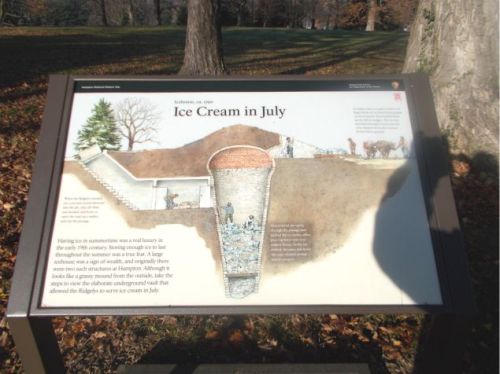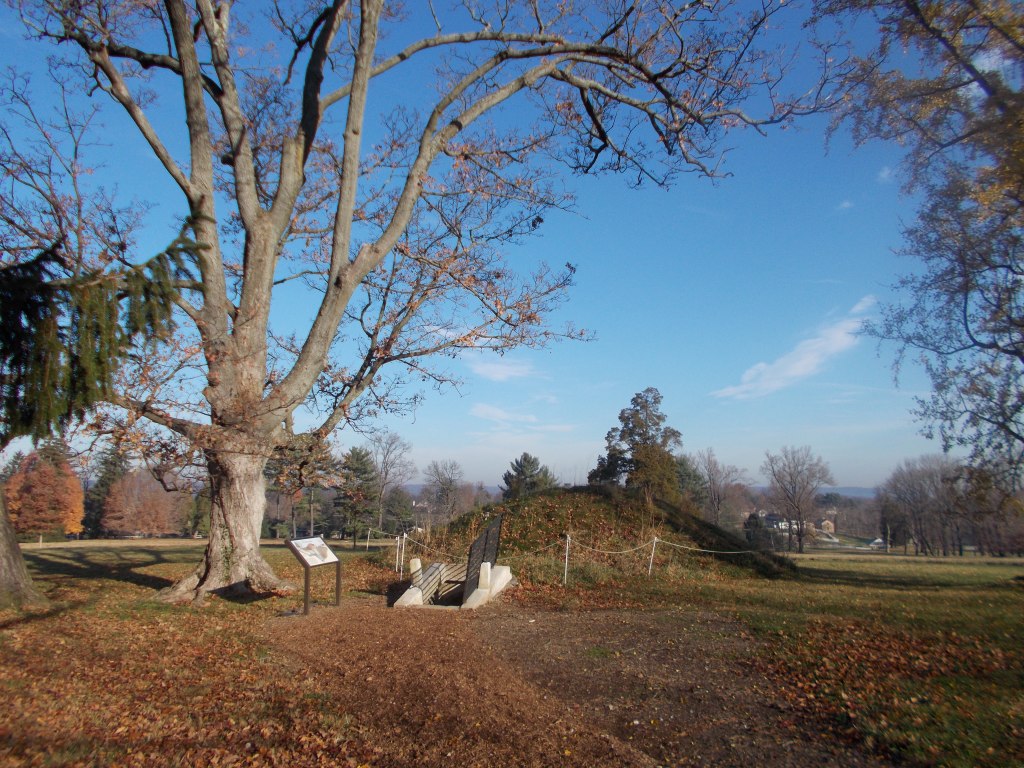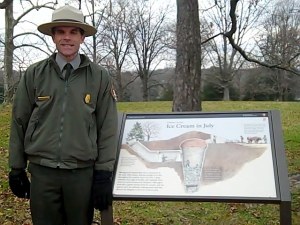Whenever I stay with my family in north Baltimore, I visit Hampton National Historic Site to walk along its extensive grounds. Construction on Hampton Hall began after 1783 and continued well into the 1800s. The Ridgely family once owned 25,000 acres of land, as well as a number of commercial, industrial, and agricultural interests that allowed them to live well and entertain lavishly. They were able to serve ice cream in July with stored ice, an expensive and time-consuming commodity in 19th century America and Great Britain.
Hampton Mansion’s ice house is located near the circular drive and in front of what once was the laundry. From a distance it resembles a grassy knoll.
The entrance is open to visitors. I clambered down the steep stairs with Alan, a park ranger who kindly guided me down the dark pit.
In winter, slaves or paid workers cut large blocks of ice from frozen ponds on the property. They handed them up the hill on sledges. The ice was shovelled through a hatch into the cone-shaped cavity that extends 34 feet below ground.” – Text, National Park Service
Men entered the cavity through the passage and packed the ice down, often pouring water over it to make it freeze. As the ice melted the mass slid down the cone-shaped pit but stayed compact.” – Text, National Park Service
When the Ridgelys needed ice, a servant would descend into the pit, chip off what was needed, and hoist or carry the load up a ladder and out the passage.” – Text, National Park Service

At the top right oxen can be seen hauling ice to the ice house. A man is dropping big blocks of frozen ice down a hole. One presumes that no one is standing in the pit below. Image @vsanborn
More on the topic:

















That’s fascinating, one doesn’t really associate ice cream with the 18th 19th centuries, we tend to think of it as something relatively new. Obviously it is not.
Collecting, storing and making so much ice back then begs the question; what else did they use the ice for, besides whiskey on the rocks (an American discovery I believe and perhaps it’s greatest export)?
But with so much they must have had many and divers uses for it, is there a record of it’s other and I’d presume main use, or is it conceivable that they were ice cream fanatics like me?
I believe Dolly Madison served a frozen dish, thought to be ice cream, as dessert at White House banquets.
There were ice-cream vendors on the streets of London in the 19th Century. But it wasn’t like now where you get your individual cone. Instead you got what was called a ‘penny lick’ – basically, they gave you a little scoop of ice cream in a small glass dish that you licked the ice cream out of before handing it back to the vendor who would then serve the next person with it. The lack of hygiene in that doesn’t bear thinking about really… All the germs were ultimately what got that method banned and so someone came up with the edible cone instead.
I’ve obviously been more intent on scoffing ice cream than reading up on it’s history, I’ll hang my head in shame and forgo my daily fix :o(
Hi Madgie,
Thanks for that bit of information. I have a few of those “penny-lick” glasses that look like small sherry glasses and always assumed they were used in sweet shops which I guess they might have been, but never knew that there were street vendors as well. So much for sanitation.
I do believe there was a trade in ice in the 19th century. Ice from north America made its way to the antipodes, India and other warmer parts, in ships filled with sawdust. According to Wikipedia at its peak it employed 90,000 people. The death knell of the trade essentially sounded when Geelong newpaperman James Harrison began icemaking in 1851, which, as a result of discussions in north and south America and Australia and New Zealand as to how to export dairy products and frozen meat to city and international markets, led to experiments in refrigeration on ships and trains.
You’ve put me to shame Kevin, an ex Melburnian of sorts I should have known this; thank you anyway I now have something else to follow up on.
I grew up in Roswell, Georgia about thirty minutes drive north of Atlanta. A town settled in the 1830’s by wealthy coastal families escaping the unsavory aspects of low country summers. There a number of beautiful Greek revival homes there one of which is Bulloch Hall, the girlhood home of Mittie Bulloch Roosevelt the mother of President Theodore Roosevelt.
The first time I encountered the concept of ice out of season or at least in a clime seemingly unfit year round was there in the story of the Roosevelt-Bulloch wedding which took place at the home on December 22,1853. Ice was brought by wagon from Savannah to enable to guests to enjoy ice-cream. I am assuming that the ice had to be shipped down the eastern seaboard from New England.
Later I lived for several years in Lexington Kentucky where one day visiting “Ashland” the home of Henry Clay, I discovered it boasted an ice house like the one featured in this post.
I watch the 1995 production of “Persuasion” (Amanda Root and Ciaran Hinds) quite often, whenever I need an Austen fix and the scene of eating ice-cream in the dining room at Kellynch Hall always brings to mind Mittie Bulloch and the ice-cream served at a wedding in Georgia long ago.
I have lived in the Baltimore suburbs my entire life and, while I have visited Hampton Mansion for a fair many years ago, I did not know of this. You’ve made me plan to visit it again for the history of the place.
I have heard of an Ice House from Persuasion. It’s WONDERFUL to actually SEE ONE!!! thanks!
Wonderful post. Thank you.
that’s so interesting, would love to visit the mansion! x
Thomas Jefferson served icecream…he brought it back from France, I believe. The picture of the ice house is so interesting!
Wow Barbara, how did he keep it for so long, I’d have thought it would have melted or been eaten long before he got back to the American shores.
SORRY, just teasing, couldn’t resist it.
;o
Though this is 100+ years later than the ice house, I thought you may enjoy this film of how the ice was collected in early 1900: http://www.farmcollector.com/1919iceharvestvideo….
Wow, fascinating stuff. I was familiar with the concept of an ice house but not the inner workings of one. So much work was involved. I should think about that whenever I open my freezer or refrigerator or reach for an ice cube!
i have read of ice being cut into blocks and straw or sawdust separating the layers. does Laura Ingalls Wilder talk about this? i forget. this is a wonderful novel way of dealing with the ice. how cleaver! great article.
I never read Laura, but Caddie Woodlawn (Minnesota pioneer a generation earlier) talked about it.
oh, Bill! thank you for reminding me of Caddie Woodlawn! i enjoyed that book. i remember she ran with her brothers and had fun. my favorite part was the watermelons in the straw in the barn! Wonderful stories.